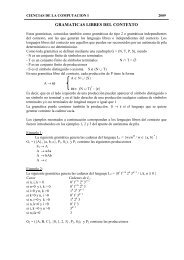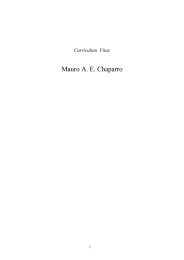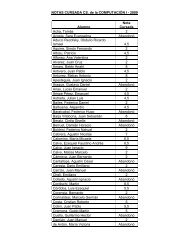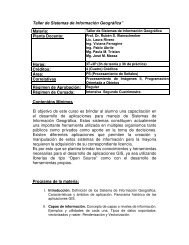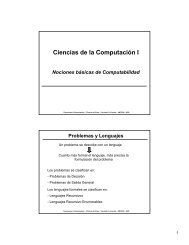Libro de Resúmenes / Book of Abstracts (Español/English)
Libro de Resúmenes / Book of Abstracts (Español/English)
Libro de Resúmenes / Book of Abstracts (Español/English)
You also want an ePaper? Increase the reach of your titles
YUMPU automatically turns print PDFs into web optimized ePapers that Google loves.
Resumenes 137<br />
the Allee effect are those related to <strong>de</strong>creasing functional and numerical<br />
responses as population size drops to very low levels.<br />
The most simple mo<strong>de</strong>l which incorporates Allee effect is the equation<br />
<strong>de</strong>rived from the logistic growth adding a new parameter:<br />
a)<br />
dx<br />
dt<br />
⎛ x ⎞<br />
= r ⎜1<br />
− ⎟ ( x − m ) x ,<br />
⎝ K ⎠<br />
[1, 3, 4, 7]<br />
where m represents the minimum viable population. With m > 0, the<br />
population exhibits strong Allee effect, and with m = 0 it exhibits a weak<br />
Allee effect. Another equations presented in the literature are:<br />
b)<br />
dx ⎛ ⎛ x ⎞⎛<br />
x ⎞ ⎞<br />
= ⎜ r⎜1<br />
− ⎟⎜<br />
⎟ − D⎟<br />
x [19]<br />
dt ⎝ ⎝ R ⎠⎝<br />
x + C ⎠ ⎠<br />
c)<br />
dx ⎛ x ⎞ ⎛ b + C ⎞<br />
= r ⎜1<br />
− ⎟ ⎜1<br />
− ⎟ x<br />
dt ⎝ K ⎠ ⎝ x + C ⎠<br />
[2]<br />
d)<br />
dx ⎛ rx b ⎞<br />
= ⎜ r − − ⎟ x<br />
dt ⎝ K x + C ⎠<br />
[16, 18]<br />
e)<br />
dx<br />
dt<br />
⎛ x ⎞<br />
= r x ⎜ ⎟<br />
⎝ x + C ⎠<br />
[20]<br />
In or<strong>de</strong>r to discuss the different biological reason that leads to an<br />
Allee effect, we are going to consi<strong>de</strong>r the following baseline mo<strong>de</strong>l with<br />
linear self-limitation<br />
dx<br />
dt<br />
= x g φ<br />
2<br />
( x,<br />
( x)<br />
) − bx<br />
where φ represents the extraction rate <strong>of</strong> resources per unit consumer and<br />
g represents the conversion rate resource to per capita population growth<br />
rate. Various functional forms can be found in [9, 11, 15, 18]. Let us<br />
assume that at low population <strong>de</strong>nsity, the reproduction or the survival are<br />
diminished or metabolic losses are increased. Then, the population requires<br />
to consume more resources in or<strong>de</strong>r to balance the extra losses or the<br />
diminished gain. Consi<strong>de</strong>ring the simplest and more wi<strong>de</strong>ly used (linear)<br />
conversion function g <strong>de</strong>pending on x we have:<br />
g( x)<br />
= ε ( φ − κ ( x)<br />
)<br />
The conversion function g <strong>de</strong>scribes the basal growth <strong>of</strong> population as<br />
a function <strong>of</strong> the feeding rate φ and the parameter κ which represents the<br />
consumption level required for zero growth. We study the mathematical<br />
equivalences <strong>de</strong>rived from this mo<strong>de</strong>ling approach respect to the ones<br />
already presented in the ecological and biomathematical literature.<br />
References<br />
[1] Brauer, F., and Castillo-Chávez, C., 2001 Mathematical mo<strong>de</strong>ls in Population<br />
Biology and Epi<strong>de</strong>miology, TAM 40, Springer.Verlag.<br />
[2] Boukal, D. S. and L. Berec, 2002, Single-species mo<strong>de</strong>ls and the Allee<br />
effect: Extinction boundaries, sex ratios and mate encounters, Journal <strong>of</strong><br />
Theoretical Biology, Vol 218, 375-394.<br />
[3] Clark, C. W., 1990. Mathematical Bioeconomic: The optimal management <strong>of</strong><br />
renewable resources, (second edition). John Wiley and Sons.



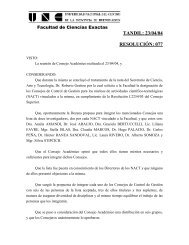
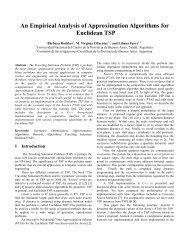
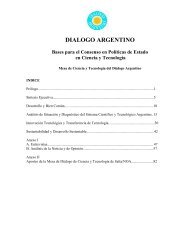


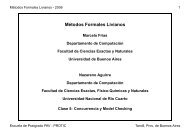
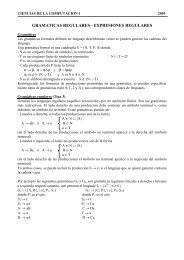

![Clase 13 [pdf]](https://img.yumpu.com/19616969/1/190x245/clase-13-pdf.jpg?quality=85)

